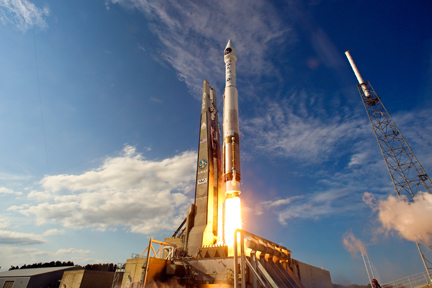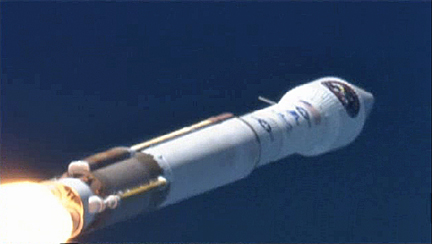Atlas 5 boosts missile early warning satellite into space
03/19/2013 05:03 PM Filed in: Space News | Military Space
By WILLIAM HARWOOD
CBS News
A United Launch Alliance Atlas 5 rocket boosted a missile early warning satellite into space Tuesday, the second in a new generation of infrared surveillance stations designed to work with other satellites providing global launch warning and battlefield awareness.
The 189-foot-tall Atlas 5's Russian-designed RD-180 engine ignited with a rush of fiery exhaust at 5:21 p.m. EDT (GMT-4) and the two-stage rocket majestically climbed away from launch complex 41 at the Cape Canaveral Air Force station.
Generating 860,200 pounds of thrust, the first stage engine burned for four minutes, pushing the rocket out of the dense lower atmosphere and putting on a spectacular afternoon show for area residents and tourists.
The first stage then fell away, the Centaur second stage's hydrogen-fueled Pratt & Whitney RL10A engine ignited and the rocket continued its climb to space.
Dramatic video from an on-board "rocketcam" showed the first stage falling away, followed a few seconds later by the two halves of the nose cone fairing with the peninsula of Florida and Lake Okeechobee in the background.
The Centaur engine shut down as planned 15 minutes and 20 seconds after launch, putting the Space Based Infrared System -- SBIRS -- GEO-2 satellite into a temporary "parking" orbit. A second three-minute 55-second firing began a little less than nine minutes later to put the satellite into an elliptical "transfer" orbit with a high point of around 22,300 miles and a low point of about 115 miles.
A forward-looking rocketcam showed the SBIRS GEO-2 satellite separating from the Centaur 43 minutes after launch as the spacecraft climbed away from Earth due east of Madagascar. Over the next nine days, the satellite's own rocket thrusters will be used to raise the low point, or perigee, of the transfer orbit, putting the craft into the desired circular orbit 22,300 miles above the equator.
Once checked out and on station -- the exact orbital location is classified -- the new satellite will represent "another big step in delivering the next generation of Air Force infrared surveillance capability," said Col. Jim Planeaux, director of the Infrared Space Systems directorate at the Air Force Space and Missile Systems Center.
The SBIRS satellites are follow-ons to the successful Defense Support Program early warning satellites that have operated continuously over the past four decades, on the lookout for the telltale heat signatures of intercontinental ballistic missiles.
The solar-powered Lockheed Martin-built SBIRS spacecraft are equipped with more sensitive detectors and are designed to work with instruments aboard satellites in highly elliptical orbits to provide both global data and targeted battlefield assessments.
"Each GEO satellite includes highly sophisticated scanning and staring sensors that will deliver enhanced infrared sensitivity and a reduction in area revisit times over the current constellation," Dave Sheridan, Lockheed Martin's SBIRS program director, told reporters.
"The scanning sensors provide a wide-area surveillance of missile launches and natural phenomena across the Earth, while the staring sensors can be tasked to observe smaller areas of interest with enhanced sensitivity."
Lockheed Martin currently holds contracts to build four GEO satellites with two more expected later. While early warning of strategic missile launches remains the core mission of the system, "I would argue that the nation's missile warning system is critical now, or perhaps even more so, than it was even during Cold War," Planeaux said.
"Certainly, strategic and tactical missile threats have proliferated in both number and type, the number of countries that own these systems has increased," he said.
In 2011 he said, the Air Force used SBIRS and DSP observations to alert U.S. and allied forces to nearly 200 missile launches around the world.
"Our current constellation of Defense Support Program satellites has served the nation and our allies well for over 40 years," Planeaux said. "SBIRS is bringing unprecedented new capabilities into service to support our mission areas, which are missile warning, missile defense, technical intelligence and battlespace awareness."
Improved sensor technology will "enable us to respond to growing needs, evolving threats, and will serve us as the foundation of the nation's overhead infrared constellation for many, many years to come," he added.
This was the 37th launch of an Atlas 5 and the fourth Atlas flight in just four months.
CBS News
A United Launch Alliance Atlas 5 rocket boosted a missile early warning satellite into space Tuesday, the second in a new generation of infrared surveillance stations designed to work with other satellites providing global launch warning and battlefield awareness.
The 189-foot-tall Atlas 5's Russian-designed RD-180 engine ignited with a rush of fiery exhaust at 5:21 p.m. EDT (GMT-4) and the two-stage rocket majestically climbed away from launch complex 41 at the Cape Canaveral Air Force station.
 |
| A United Launch Alliance Atlas 5 rocket climbs away from launch complex 41 at the Cape Canaveral Air Force Station Tuesday, boosting a new missile early warning satellite toward orbit. (Credit: Pat Corkery/United Launch Alliance) |
The first stage then fell away, the Centaur second stage's hydrogen-fueled Pratt & Whitney RL10A engine ignited and the rocket continued its climb to space.
 |
| A long-range tracking camera zooms in on the Atlas 5 as it climbs out of the lower atmosphere. (Credit: United Launch Alliance webcast) |
The Centaur engine shut down as planned 15 minutes and 20 seconds after launch, putting the Space Based Infrared System -- SBIRS -- GEO-2 satellite into a temporary "parking" orbit. A second three-minute 55-second firing began a little less than nine minutes later to put the satellite into an elliptical "transfer" orbit with a high point of around 22,300 miles and a low point of about 115 miles.
 |
| In this dramatic view, the first stage can be seen falling away in the center of the frame, flanked by the two halves of the nose-cone shroud as they fell away. The Florida peninsula and Lake Okeechobee are visible in the background. (Credit: United Launch Alliance webcast) |
Once checked out and on station -- the exact orbital location is classified -- the new satellite will represent "another big step in delivering the next generation of Air Force infrared surveillance capability," said Col. Jim Planeaux, director of the Infrared Space Systems directorate at the Air Force Space and Missile Systems Center.
The SBIRS satellites are follow-ons to the successful Defense Support Program early warning satellites that have operated continuously over the past four decades, on the lookout for the telltale heat signatures of intercontinental ballistic missiles.
The solar-powered Lockheed Martin-built SBIRS spacecraft are equipped with more sensitive detectors and are designed to work with instruments aboard satellites in highly elliptical orbits to provide both global data and targeted battlefield assessments.
"Each GEO satellite includes highly sophisticated scanning and staring sensors that will deliver enhanced infrared sensitivity and a reduction in area revisit times over the current constellation," Dave Sheridan, Lockheed Martin's SBIRS program director, told reporters.
"The scanning sensors provide a wide-area surveillance of missile launches and natural phenomena across the Earth, while the staring sensors can be tasked to observe smaller areas of interest with enhanced sensitivity."
Lockheed Martin currently holds contracts to build four GEO satellites with two more expected later. While early warning of strategic missile launches remains the core mission of the system, "I would argue that the nation's missile warning system is critical now, or perhaps even more so, than it was even during Cold War," Planeaux said.
"Certainly, strategic and tactical missile threats have proliferated in both number and type, the number of countries that own these systems has increased," he said.
In 2011 he said, the Air Force used SBIRS and DSP observations to alert U.S. and allied forces to nearly 200 missile launches around the world.
"Our current constellation of Defense Support Program satellites has served the nation and our allies well for over 40 years," Planeaux said. "SBIRS is bringing unprecedented new capabilities into service to support our mission areas, which are missile warning, missile defense, technical intelligence and battlespace awareness."
Improved sensor technology will "enable us to respond to growing needs, evolving threats, and will serve us as the foundation of the nation's overhead infrared constellation for many, many years to come," he added.
This was the 37th launch of an Atlas 5 and the fourth Atlas flight in just four months.